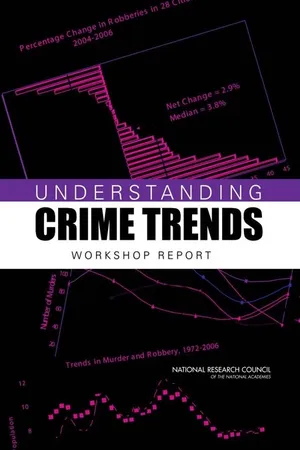
- English
- ePUB (mobile friendly)
- Available on iOS & Android
About this book
Changes over time in the levels and patterns of crime have significant consequences that affect not only the criminal justice system but also other critical policy sectors. Yet compared with such areas as health status, housing, and employment, the nation lacks timely information and comprehensive research on crime trends.Descriptive information and explanatory research on crime trends across the nation that are not only accurate, but also timely, are pressing needs in the nation's crime-control efforts.In April 2007, the National Research Council held a two-day workshop to address key substantive and methodological issues underlying the study of crime trends and to lay the groundwork for a proposed multiyear NRC panel study of these issues. Six papers were commissioned from leading researchers and discussed at the workshop by experts in sociology, criminology, law, economics, and statistics. The authors revised their papers based on the discussants' comments, and the papers were then reviewed again externally. The six final workshop papers are the basis of this volume, which represents some of the most serious thinking and research on crime trends currently available.
Frequently asked questions
- Essential is ideal for learners and professionals who enjoy exploring a wide range of subjects. Access the Essential Library with 800,000+ trusted titles and best-sellers across business, personal growth, and the humanities. Includes unlimited reading time and Standard Read Aloud voice.
- Complete: Perfect for advanced learners and researchers needing full, unrestricted access. Unlock 1.4M+ books across hundreds of subjects, including academic and specialized titles. The Complete Plan also includes advanced features like Premium Read Aloud and Research Assistant.
Please note we cannot support devices running on iOS 13 and Android 7 or earlier. Learn more about using the app.
Information
Table of contents
- COVER PAGE
- THE NATIONAL ACADEMIES
- COMMITTEE ON UNDERSTANDING CRIME TRENDS
- COMMITTEE ON LAW AND JUSTICE
- Acknowledgments
- Preface
- Contents
- 1 Introduction
- 2 Factors Contributing to U.S. Crime Trends
- 3 Gender and Violence in the United States: Trends in Offending and Victimization
- 4 Crime and Neighborhood Change
- 5 An Empirical Assessment of the Contemporary Crime Trends Puzzle: A Modest Step Toward a More Comprehensive Research Agenda
- 6 Forecasting Crime: A City-Level Analysis
- 7 On the Use of Aggregate Crime Regressions in Policy Evaluation